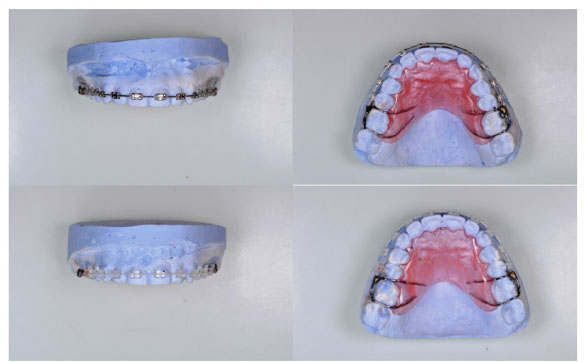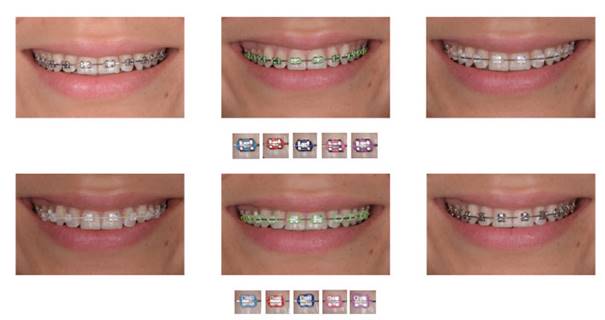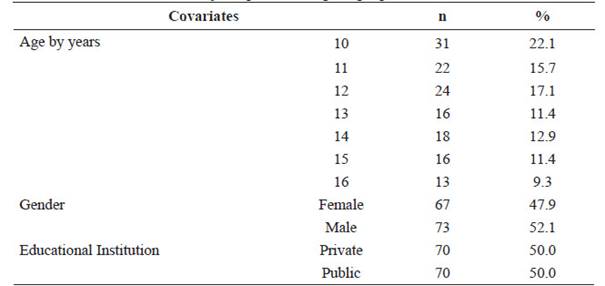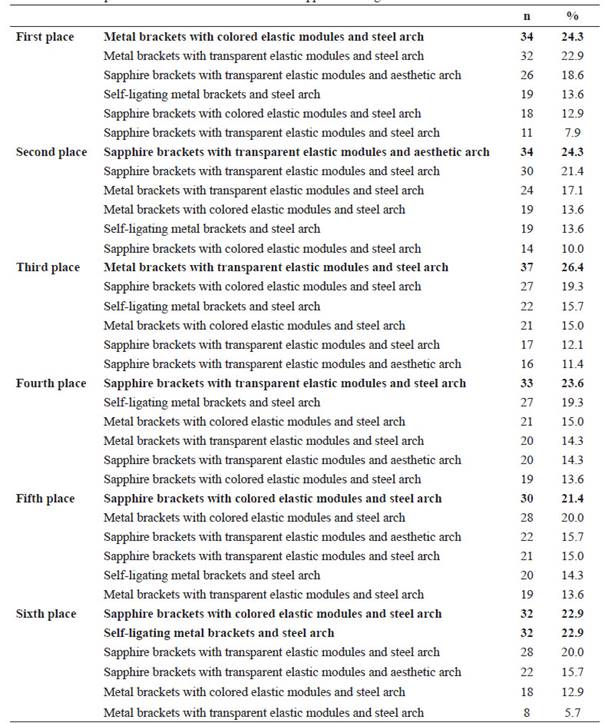INTRODUCTION
The orthodontic market has experienced phenomenal growth in the development and production of orthodontic appliances that are designed to appeal to the patient 1. A shifting paradigm toward dental esthetics, increased demand for orthodontic treatment 1,2. Considering that age influences the perception of esthetics, understanding the factors involved in a particular population enables better planning of resources and strategies in private practice. The appearance of orthodontic appliance plays a significant role in patients’ decisions to undergo orthodontic therapy 3.
Few studies have investigated patients’ perceptions towards orthodontic fixed appliances. Ziuchkovski et al.,(4) and Rosvall et al.,(2 found that attractiveness and acceptability varied significantly by appliance type. These studies showed that adult consumers value less metal showing in their brackets and were less willing to accept treatment with appliances they consider to be unesthetic 2,4. At that point, no one asked children and adolescents what they favor for orthodontic appliances and their esthetics. Children and adolescent preferences differ from adult, which increase the demand for further studies to evaluate their perception as patient acceptance affect compliance and motivation, thus leading to more successful treatment outcomes 1,5,6.
The purpose of this study was to evaluate preference and acceptability of six different orthodontic fixed appliance designs in Peruvian adolescents from two schools in Lima. The importance comes in that it is the first study in this field to be conducted in a Peruvian sample and the results will increase awareness of the preferred orthodontic appliances by this age group, which could be major factor for patient compliance and motivation to achieve successful treatment outcomes. This information will help clinicians recognize and meet the demands of young patients in their practices and provide a baseline of data to be used to assess future changes in patient preferences.
MATERIAL AND METHODS
This research was approved by the ethics research committee of Universidad Peruana Cayetano Heredia. A model was selected for placement and imaging of the orthodontic appliances on basis of good alignment of teeth, adequate gingival and incisal exposure and the absence of strong sex markers in the circum-oral region. The volunteer was also asked to sign the informed consent. Digital image capture was made in a frontal view with an SLR camera (D600 Nikon, Nikon Corp. Japan, Thailand) equipped with a macro lens AF-S Micro Nikkor 105 mm 1:2.8G IF-ED (Nikon Corp. Japan, China) and R1C1 wireless close-up speedlight system (Nikon Corp.Japan, China).Traditional metal brackets (Mini Master, American Orthodontics, Wisconsin, USA), sapphire esthetic orthodontic brackets (Radiance, American Orthodontics, Wisconsin, USA) and self-ligating metal brackets (Empower, American Orthodontics, Wisconsin, USA) were placed in two custom removable appliances that allowed precise and reproducible placement different orthodontic appliance designs. Brackets were not bonded to prevent enamel damage (Figure 1). Two photo albums were elaborated in which only the position of the images was modified to avoid memory bias.

Figure 1 Custom removable appliances that allowed precise and reproducible placement different orthodontic appliance designs
A descriptive cross-sectional study was executed in two educational institutions, one public (CJB) and one private (SVP) with a total sample of 140 subjects (70 per institution). To determine the sample size, data from the pilot study was used in a formula for estimating a proportion. It was found that a minimum sample of 89 subjects (adjusted for 15% losses) was needed, considering a confidence level of 95%, significance level of 0.05 and precision of 5%. The inclusion criteria were: students between 10 and 16 years who agreed to be part of the study and the exclusion criteria were students with direct family dentists and history or orthodontic treatment in progress. In each classroom an informed consent form was distributed to request the participation of the students and sent home for consultation and signing by their parents. The minors signed an informed assent. Data were collected by a questionnaire asking about demographic information: age, gender, school type, direct family dentists and previous family history of orthodontic treatment. Each rater received an album with smile pictures of good quality prints. The first sheet showed the 6 images of the different designs of orthodontic appliances in the study identified with letters from A to F (Figure 2). To assess preference, the participant marked the letter of the preferred orthodontic appliance design. Likewise, they were asked to order the images in descending order (highest to lowest preference). To assess acceptability, they were asked if they would be willing to use a certain appliance design if it was necessary to undergo orthodontic treatment to which they had to answer yes/no; combinations of two appliance images were made to compare the acceptability to use of each design 1. The average time to carry out the entire questionnaire was 10 to 15 minutes.

Figure 2 Different designs of othodontic appliances in the study identified with letters from A to F. A Metal Brackets with transparent elastomeric modules and steel archwire; B metal brackets with colored elastomeric modules and steel archwire; C sapphire with transparent elastomeric modules and steel archwire; D sapphire brackets with transparent elastomeric modules and aesthetic archwire; E sapphire brackets with colored elastomeric modules and steel archwire and F self-ligating metal brackets and steel archwire.
Statistical Analysis
The data collected were entered using Microsoft Excel program. Data analysis was performed using the Statistical Package of the Social Sciences (SPSS) program version 24.0. A p-value of less than 0.05 was considered as a level for significance. The results were expressed in terms of proportion and frequency. Due to the nature of the variables (qualitative) the Chi square test was used.
RESULTS
The total sample consisted of 140 adolescents with an age average of 12.49 years (range 10-16 years), of which 67 (47.9%) were female and 73 (52.1%) were male. The results of the descriptive statistics of the study group according to age, sex and educational institution are shown in Table 1. The sample was divided into two age groups according to life stage: 10-13 years (early adolescent) and 14-16 years (late adolescent). These age groups were chosen based on scientific support since differences have been found in terms of age and sex. 1 In general, it was found that adolescents preferred metal brackets with colored elastic modules and steel archwires (24.3%, n=34); and that in terms of acceptability, 92.1% of the study group would agree to use the chosen appliance design (Table 2 and Table 3).
Table 1 Distribution of the study sample according to age, gender and educational institution.

n: Absolute frequency
%: Relative frequency
N=140
Table 2 Preference of different orthodontic fixed appliance designs in Peruvian adolescents

n: Absolute frequency
%: Relative frequency
N=140
Table 3 Acceptability of different orthodontic fixed appliance designs in Peruvian adolescents

n: Absolute frequency
%: Relative frequency
N=140
Regarding the order of preference, the following hierarchy was found from first to sixth place: metal brackets with colored elastic modules and steel arch> sapphire brackets with transparent elastic modules and aesthetic arch> metal brackets with transparent elastic modules and stainless steel arch> sapphire brackets with transparent elastic modules and steel arch> sapphire brackets with colored elastic modules and steel arch> self-ligating metal brackets and steel arch/sapphire brackets with colored elastic modules and steel arch (Table 4).
Table 4 Order of preference different orthodontic fixed appliance designs in Peruvian adolescents

n: Absolute frequency
%: Relative frequency
N=140
The results for acceptability for use among the nine options (two combinations per question) were proposed in the registration form. For the order of preference in fifth place (p<0.01), a statistically significant association was found between the educational institution and the design of the chosen fixed orthodontic appliance. A statistically significant association was also found for the first question of acceptability to use, between life stage and design of fixed orthodontic appliances (p<0.01), participant's sex and the design of fixed orthodontic appliances chosen for the second question (p<0.01); third question (p = 0.001); fourth question (p<0.01); for the eighth question (p=0.01) and the ninth question (p<0.01). On the other hand, a statistically significant association was found between the educational institution and the design of the fixed orthodontic appliance chosen for acceptability for use in the second question (p=0.027); third question (p<0.01) and eighth question (p=0.042).
DISCUSSION
Orthodontic appliances have evolved according to public demand and available technology. Today, there are innumerable variations in brackets designs in terms of size, shape, method of bonding and incorporation of plastic or ceramic materials. The tendency to reduce the visibility of braces in Orthodontics suggests that patients are more willing to accept a treatment with more clear appliances instead of traditional metal brackets. There is limited literature and most studies have been conducted in adult subjects 1,7. Previous studies reported that adult patients prefer appliances that expose less metal 2,4. However, Walton et al. conducted the first study to evaluate the preference and acceptability of fixed orthodontic appliances in children and adolescents founding substantial differences according to age in contrast to adults 1 Although the demand for orthodontic treatments by adult patients has increased, adolescents continue to represent the highest percentage in private practice which is why the purpose of this study was to evaluate the preference and acceptability of six different appliance designs fixed orthodontic treatment in Peruvian adolescents from two schools in Lima.
A registration form was used to evaluate the preference, acceptability, order of preference and acceptability to use on six different designs of fixed orthodontic appliances. Even though most of the studies use the visual analogue scale to evaluate these variables, the use of a record sheet was opted since no categorization of the scale was found in any of the studies reviewed. Likewise, the study carried out by Barber et al. pointed limitations of the use of the visual analogue scale to evaluate the aesthetics of the smile in adolescents, founding that it presented low reliability for this age group 8.
Results show that, in general, adolescents prefer metal brackets with colored elastic modules and a steel archwires (24.3%, n = 34), which is related to the findings of Walton et al., 1,7 in which metal twin brackets with colored elastic modules were the most preferred. In terms of acceptability, it was found that 92.1% of the study group would agree to use the chosen appliance. The acceptability variable was evaluated by questioning the participant about whether they would be willing to use the fixed orthodontic appliance design of their choice and their values were yes/no. However, the value for acceptability differs from the one found in adult subjects where metal brackets present the least preference (2,4,9). It was interesting to find that metal brackets with colored elastic modules, which are generally the cheapest option and are frequently used by orthodontists, were the most preferred and had a high acceptability, which is consistent with previous reports 1,7.
Regarding the order of preference, the hierarchy was congruent with the findings of Walton et al., 1, but opposed to the ones on adult individuals since for this age group the less visible options such as transparent aligners or lingual brackets occupy the first places, followed by aesthetic brackets (ceramic/sapphire), and finally by twin metallic and self-ligating brackets 2,4,7,9,10.
In this study, the type of educational institution (private or public) was considered as a covariate; this point was not considered in the study by Walton et al., 1,7, which was a continuation of the project carried out by Ziuchkovski et al., 4 and Rosvall et al., (2, only applied to participants between 10 and 17 years but not to adults. It is also worth mentioning that the study subjects had never received orthodontic treatment as in this study, but were recruited from the Ohio University Dental Clinic, so they were subjects who might have been familiar with this type of device, and in turn this prior knowledge could influence the preference and acceptability of a certain type of appliance 2,4.
To evaluate the acceptability of use, the participant put him/herself in the place of a patient who was only given two options to choose from in case of the need of an orthodontic treatment. In the first question of acceptability, the two combinations shown were metal brackets with colored elastic modules and a steel arch and metal brackets with transparent elastic modules and a steel arch, for the age group 10-13 years the acceptance percentages were quite similar, however, for the 14-16 years group the highest percentage was for appliances with transparent elastic modules (72.3%). Walton et al., 1, found that as the age of the evaluators increased they began to opt for less noticeable options. The females obtained the highest percentage for the appliances considered more aesthetic compared to the males. This is similar to previous findings where the preference differed by sex and age but the association in relation to acceptability to use was not evaluated 1. Kuhlman et al., 3 evaluated the aesthetic perception of different designs of fixed orthodontic appliances in children and adolescents and also analyzed the preference according to the age, sex and socioeconomic level. For this purpose, photographs were evaluated with a visual analogue scale. Regarding aesthetic appeal, the hierarchy found for children was: traditional metal brackets with green elastic modules> metal brackets with gray elastic modules> sapphire aesthetic brackets, while for adolescents it was: sapphire aesthetic brackets> transparent aligners without attachments> metal brackets with green elastic modules, respectively. Metal brackets were considered very attractive, despite the fact that aligners, which are considered an aesthetic option, were classified as less attractive by both sexes in the case of children. These results are consistent with the present study since metal brackets with colored elastics were the most preferred, and in the same way as the age of the evaluator increased, they opted for the less visible options. Male adolescents showed greater preference for aesthetic appliances meanwhile there was no difference for females. Recently, Suliamani et al., 6) carried a cross-sectional study that aimed comparing the esthetic perception of different orthodontic appliances between children and adolescents living in Makkah, Saudi Arabia. The chi-square analysis showed a significant difference in esthetic perception of different orthodontic appliances between the two age groups (6-12 and 15-18), the majority of children choose a metallic appliance with colored elastics as they look attractive, while adolescents choose regular metallic brackets, which is similar to this study results.
The results must be interpreted with caution since they cannot be fully contrasted with previous studies due to the fact that the population reported in the literature has been mainly adults, only Walton et al., 1,7 and Kuhlman et al., 3) conducted studies on an adolescents. Second, because of the evaluation method, since almost all the studies used the visual analogue scale to assess attractiveness, preference and acceptability, in contrast of this study in which a registration form was used because of the absence of a categorization of the visual analogue scale. Likewise, the study carried out by Barber et al., 8, regarding the limitations of its use for the evaluation of smile aesthetics in adolescents, found that it presented low reliability for this age group. There were also differences in the designs of the appliances used for the elaboration of the photo album. Finally, because other covariates were evaluated, such as the type of institution to which the participants belonged, which could be related to the participant's socioeconomic level, which for the public school would correspond to a low level and for the private one, a medium-high one; in addition to other covariates such as the order of preference and acceptability to use that have not been previously reported.
The data obtained from this study is valuable because information about preference and acceptability of fixed orthodontic appliance designs is scarce in the literature and even more so in the age group studied (adolescents) so, it will serve for future researches. Furthermore, the comparison of these results with previous studies will allow to highlight the differences between age groups. This information will help recognize the demands of young patients and could be used to assess future changes in preferences; it will improve the planning of resources, strategies and services provided by orthodontists to satisfy patient’s needs.
Results suggests that adolescents preferred metal braces with colored elastic modules and stainless steel archwires and that 92.1% of the total sample would agree to use the chosen appliance. We suggest future researchers to increase the sample size in order to determine if the frequency trend remains the same.














